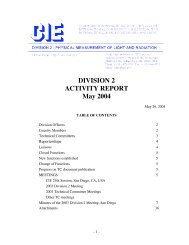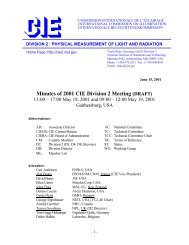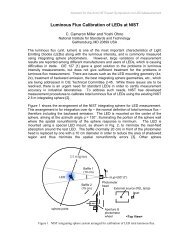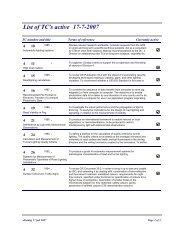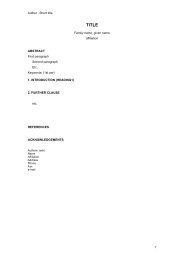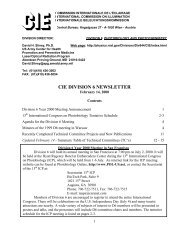ACTIVITY REPORT DIVISION 1 - cie
ACTIVITY REPORT DIVISION 1 - cie
ACTIVITY REPORT DIVISION 1 - cie
Create successful ePaper yourself
Turn your PDF publications into a flip-book with our unique Google optimized e-Paper software.
membership. H. Yaguchi JP and Nakano JP agreed at the meeting to make additional visual<br />
experiments with the test samples.<br />
There was a working meeting of several TC1-63 members after the BAM- DIN-Workshop on<br />
Image Technology in December 2007 in Berlin. At this meeting the preliminary results of four<br />
countries with the test chart samples were discussed. There were experimental reports of P.<br />
Vik Cz, P. Kittelmann GE, M. Melgosa ES and R. Luo GB who sent a written report. In all<br />
reports the test chart samples with large colour differences have been used. There were some<br />
differences in the viewing and presentation conditions compared to the first results of P.<br />
Kittelmann. Additionally threshold data and data of the industrial range (1 to 5 CIELAB) were<br />
included in three reports. J. Schanda was present and became interested to do additional<br />
experiments with the samples. T. Seim NO who works on colour vision models became a new<br />
TC member.<br />
The preliminary results of the four research reports may be interpreted as follows:<br />
Four large CIELAB colour differences greater than 10 the CIELAB formula seems to be<br />
better or equivalent to CIEDE2000. In the range near 3 to 5 CIEDE2000 is better compared<br />
to CIELAB. M. Melgosa showed that for thresholds there is a large difference between both<br />
formulas and experimental results. A description is unknown. Klaus Witt who made many<br />
experiments for the CIE report on industrial colour differences (CIE Report 142,<br />
Improvement to industrial colour difference evaluation) mentioned that near threshold about<br />
20% of the observers evaluate a colour difference if the samples are identical. The small<br />
(hairline) separation or gloss effects and other reasons may lead to these strange results. It is<br />
not really known how to identify and eliminate the incorrect data from the evaluation.<br />
A production of small colour differences of adjacent samples by image technology instead of<br />
making two physical samples which are presented side by side may avoid this problem. P.<br />
Kittelmann had produced the threshold differences of two adjacent samples by lighting<br />
technology. He puts some additional light on one half of a rectangular uniform sample and<br />
measures the threshold (50% detection probability of the difference).<br />
The preliminary and further results will be discussed during the next TC1-63 meeting in<br />
Stockholm in June 2008. During this meeting there will be a demonstration of small and<br />
medium colour differences produced by image technology, see for example 5 and 16 step<br />
colour scales at the URL: http://www.ps.bam.de/ZE95/10L/L95E00NP.PDF<br />
TC1- 64 (C) Terminology for Vision, Color, and Appearance<br />
Year Established: 2003<br />
Terms of Reference:<br />
To monitor the terminology requirements of Division 1 including the revision of the present<br />
ILV terms and the addition of new terms.<br />
Chairman: S. McFadden, CA<br />
Members: P Bodrogi HU, EC Carter US, O da Pos IT, J Gardner, AU, Y Nakano JP, MR<br />
Pointer GB, J Schanda (HU), R. Seve (FR)<br />
18




